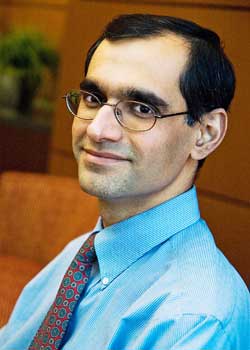The complexity that lies below the surface

Kamran Siddiqui does fundamental research with huge potential.
Rob Maguire
Ocean and atmosphere are two huge reservoirs of energy coupled together via a common boundary — the ocean surface.
Deep ocean currents flow around the planet without much impact on the world above. Likewise, high altitude winds have little effect on life below the surface. But when these two fluids come in close contact with each other, little turbulences and vortices form complex flow interactions within very thin layers above and below the ocean surface.
This is the realm of Kamran Siddiqui (Mechanical and Industrial Engineering), who believes very strongly in fundamental research.
“We have to understand how things work at a very basic level before we can use that knowledge appropriately.” He focuses on a number of areas in thermofluids, which still lack fundamental understanding.
His work on the thin layers at the boundary between flowing substances aims at understanding the fluid dynamical processes that occur there and how they influence the heat and mass transfers across the boundary. He pointed out that these dynamics are not well understood, in part because the instrumentation for measuring them was not very advanced until recently.
“We now have non-intrusive measurement technology which allows us to look at these very small regions,” a centimetre or two on either side of the boundary.
As with most basic research, the potential applications are quite broad.
One of Siddiqui’s grad students is looking at flow properties of air in the few centimetres above the surface of water.
“This is significant because field measurements are typically taken between one and 10 metres above the surface,” Siddiqui explained, “but flow properties change drastically when you approach the surface.”
Results from greater heights cannot predict what happens in these boundary regions. In the absence of near-surface measurements, however, the results from higher up have formed the basis for most of the climate models used worldwide.
“This boundary region actually has a great role in regulating climate, so our goal is to understand the basic physical processes that impact heat and mass transfer to eventually improve the accuracy of the global models.”
Another grad student is studying the thermal performance of solar collectors and examining different designs for improving their performance. Ultimately, they hope to apply their findings to devices such as solar water heaters that will work in cold climates.
“Most of the work in this area has been done in the tropics,” Siddiqui said, “not here, where in winter more than 20 per cent of the energy is utilized for water heating.”
His other area of research, thermoacoustics, has garnered him a Petro Canada Young Innovators Award. The focus of this research is the development of a prototype for a sustainable air conditioning unit for automobiles.
“Essentially, it is possible to convert heat energy into sound energy in a specialized device called a thermoacoustic engine.” The sound energy can subsequently be used to drive a thermoacoustic refrigeration process. They plan to use waste heat from engine exhaust to produce the sound energy required to power refrigeration.
“It’s simple in design, there are no moving parts, and it will eliminate the need for harmful refrigerants,” Siddiqui said. When they finalize the design, the system will be scalable and have broad applications.
“We’re focusing on waste heat as the driving force for refrigeration, but it could just as easily be solar energy.” So one day, the same summer sun that makes us seek out air-conditioned buildings may also power the cooling process within them.